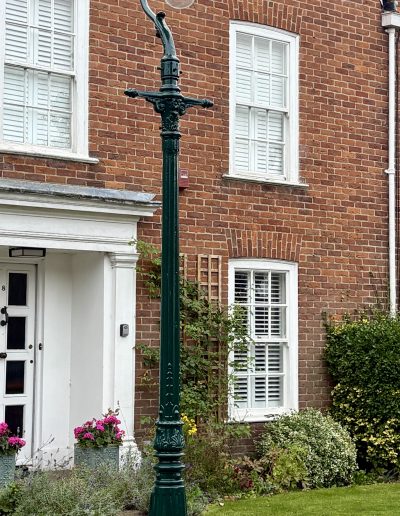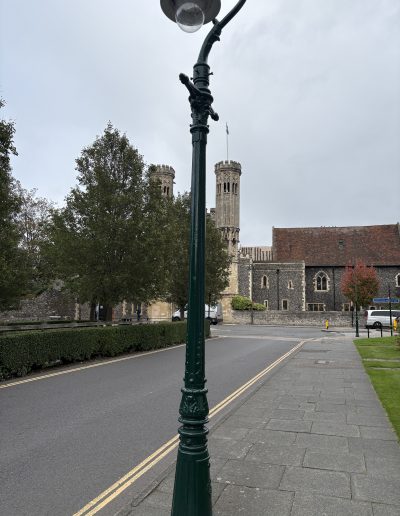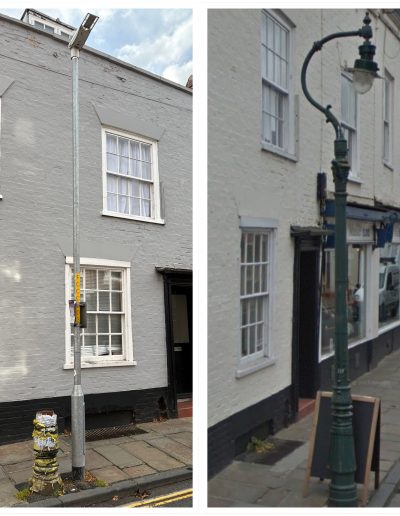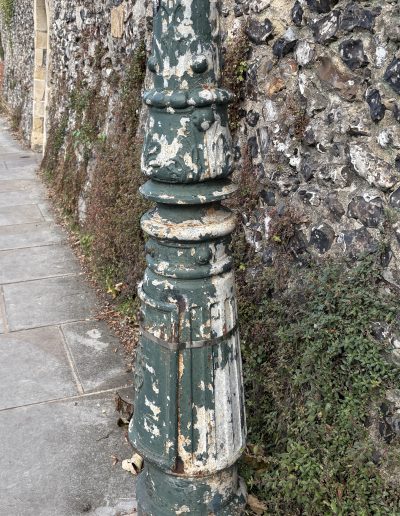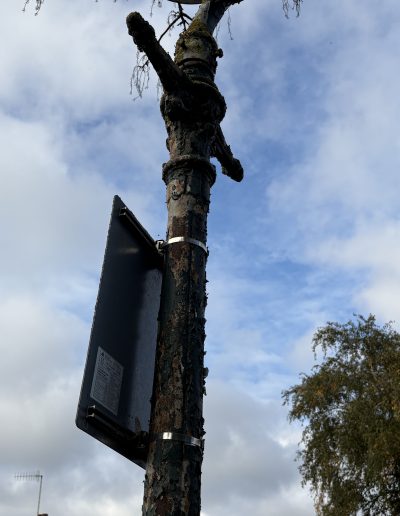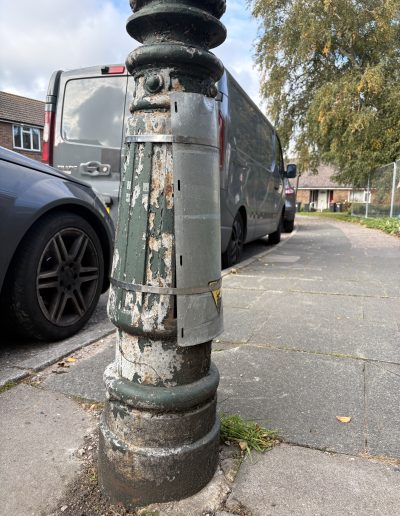Heritage Lamp Posts Under Threat
‘A stitch in time’ – poor maintenance of our heritage assets is leading to a state of managed decline.
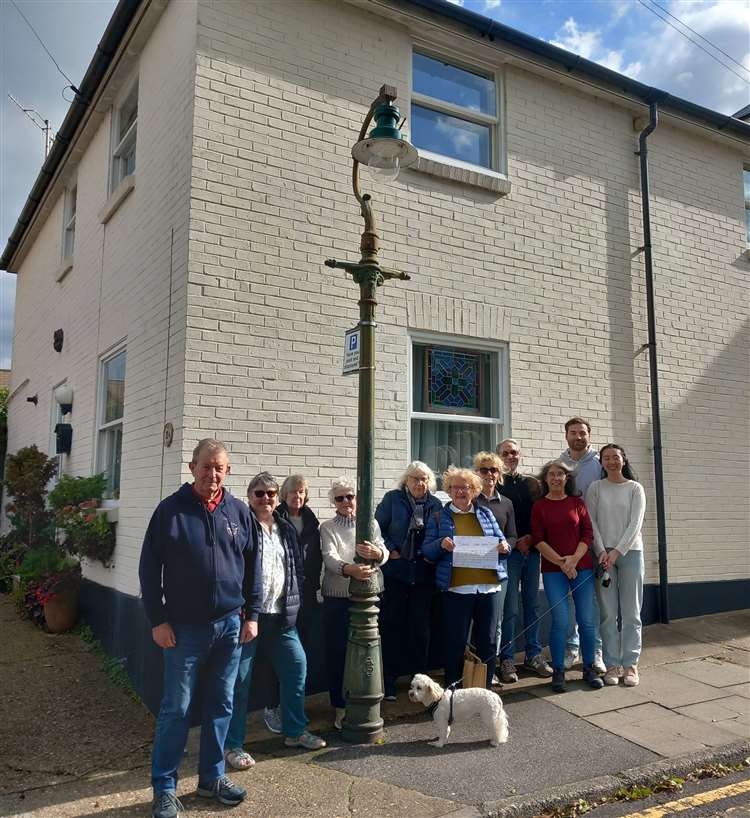
Residents unite to oppose ‘heritage erosion by stealth’
Plans to remove nine original cast-iron lampposts in Cossington Road have sparked a strong backlash from local residents and heritage experts, who describe the move “a needless act of cultural vandalism.”
The lampposts – some bearing the mark of the former H. M. Biggleston & Sons Foundry (1835–1963) are cherished features of the conservation area, complementing its intact rows of Victorian terraced homes.
Kent County Council claims the columns have “multiple defects” and are unsafe, proposing to replace them with standard steel poles fitted with bolt-on embellishments to simulate heritage styling. But campaigners say the proposed replacements are aesthetic downgrades, wasteful, and undermine the area’s authentic character.
⸻
“A shocking waste of public money”
Clive Bowley, Chair of the St Peter’s Residents’ Association and lead for the Canterbury Society’s Architecture, Planning and Streetscape Group commented:
“I find it extremely difficult to understand how a massive cast iron casting can have failed a structural test. These could easily be repaired and redecorated. Taking them away and replacing them with fake heritage lampposts would be a shocking waste of public money.”
“Brighton Council are currently in the process of restoring their original Victorian lamp standards along the seafront at Madeira Drive. Why is Canterbury falling behind?”
Clive questioned why, despite £21 million of Levelling Up funding being available for street and public realm improvements, none appears to have been used to secure a casting pattern for the city’s lost Biggleston standards – a small investment that could safeguard authenticity for decades.
“I still believe refurbishment need not be as expensive as ripping out the columns and replacing them with tawdry standardised alternatives.”
He and others have repeatedly asked KCC to release their structural engineers’ condition reports – but with no success.
⸻
Neglect by design?
Campaigners argue that the threat to Canterbury’s historic lampposts is not just about safety – it’s about long-term neglect and missed opportunities.
In Lady Wootton’s Green, where similar Biggleston columns still stand, residents recently paid out of pocket to have their lampposts professionally repainted at a cost of just £184 each. “A modest sum,” one resident noted, “to protect something irreplaceable.”
In contrast, KCC’s replacement approach is purportedly to cost over £4,000 per column – more than twenty times the cost of simple refurbishment, and even the generic ‘off-the-shelf’ post with an embellishment kit would cost over £1,200.
The situation is made worse by Canterbury City Council’s selective repainting under the Levelling Up Fund (LUF). Despite a multi-million-pound budget, only a handful of the ~200 Biggleston posts across the city are being addressed, leaving the rest to visibly decay.
⸻
Guy Mayhew of the Canterbury Society, described this as “wilful dereliction”:
“Failing to maintain these features allows the case for removal to build itself. What’s the point of all this levelling-up money if we can’t even preserve the very character that makes our city distinct?
⸻
“There’s no enforceable design code” – and that’s the problem
This isn’t an isolated issue. Over two years ago, Guy warned of precisely this problem in a presentation at a public meeting following the Longport active travel scheme controversy.
He explained how KCC, as a statutory undertaker, operates under General Permitted Development (GPDO) rights, meaning it can install or replace street infrastructure without planning permission – especially in the absence of clear local standards.
“Without a Design Code or Streetscene SPD, there’s no enforceable requirement for KCC to preserve or replace like-for-like.”
Guy’s report identified how councils like Bury St Edmunds and Croydon use tools including detailed Supplementary Planning Documents (SPDs), strategies, and — in some cases — even Article 4 Directions, to clearly define (and therefore enforce) heritage-sensitive design in their public realm.
“Until Canterbury adopts similar protections,” he warned, “we will keep losing authentic, historic street features – not by decision, but by default.”
⸻
A wider concern for conservation
Residents across the city are increasingly worried that what happens in Cossington Road will set a precedent.
“These lampposts are found all over Canterbury,” said David Kemsley, Chair of the Oaten Hill and South Canterbury Association (OHSCA).
“If they aren’t restored properly now, the cheap imitations KCC is proposing could eventually be installed across the entire city – including within the city walls.”
David stressed that Canterbury’s status as a UNESCO World Heritage Site comes with permanent obligations to maintain high standards of heritage conservation, obligations which many feel local authorities are disregarding.
“This is just one glaring example of a wider pattern – infrastructure being neglected, planning decisions eroding local character, and heritage lost by attrition.”
What happens next?
Campaigners are now calling on CCC and KCC to:
- Pause further removals of original lampposts
- Work collaboratively on a properly costed refurbishment plan
- Accelerate adoption of a detailed city-wide Public Realm Design Code
- Embed clear heritage standards in all infrastructure projects
“This isn’t simply nostalgia,” David added. “At the centre of this issue is foresight. Good design guidance will serve the city for years to come – across administrations, across generations. The heritage inertia of the past decade is frankly quite unacceptable.”
Guy adds: “For any Design Code or Public Realm SPD to carry real weight, it has to be specific enough to be enforceable. Vague principles won’t stop KCC from defaulting to standardised, characterless street furniture. We need clear technical standards that apply across departments – not just aesthetic aspirations.”
What can you do?
If you live in a conservation area, or care about Canterbury’s unique streetscape:
- Contact your City and County councillors and ask them to oppose the removals and what they’re doing to preserve Canterbury’s historic streetscape.
- Share your support with local campaigners and groups like OHSCA and the Canterbury Society
- Feed your views into the new Design Code work now underway – the Council is currently collecting public feedback on the visual quality of new development.
Let’s not lose the fabric of our historic city by silence or slow erosion.
Note: The Canterbury Society extends its thanks to Jenny and Allen MacDonald for allowing us to republish their photograph and to the Oaten Hill and South Canterbury Residents Association (OHSCA) for raising this important issue.

